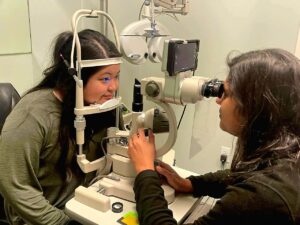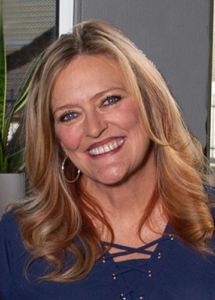
Dipa Kodukula, OD, performing slit lamp examination during an eye exam in Dr. Sorrenson’s practice.
A metric essential for you to track.
By Laurie Sorrenson, OD, FAAO
Jan. 17, 2024
Remember that article I wrote about my favorite metrics in 2023? Well, since then, I have come across some interesting stuff both at my office and during consultations with other practices… and after chatting with my go-to consultant, Bethany Fishbein, OD, I have come to believe there is ONE metric that we should be starting with! And then the other metrics we track are about how to affect that ONE particular metric.
What metric is it you ask? 🙂
I believe that collections (receipts or money in the bank) per doctor clinical hour is the first metric we should be watching now.
Why?
Let me give a personal example.
I have one doctor who at one point was by far the highest $/exam (which is usually the metric a lot of people think is most important). I also used to think that $/exam was the most important metric too. But she is a NeuroVisual doctor and sees WAY fewer patients, and initially her $/hour were lower than the other associate doctors.
I would not have realized that she was not as productive as the other doctors if I had not been analyzing the $/hour. Because of that knowledge, we analyzed all of the other metrics, figured out a few things, and she has become one of the most productive doctors now in our office! Great for her, too, as she is paid on “production” (really on collections).
Other Articles to Explore
Another office evaluated showed one of the associates having a much higher $/exam number as she did a lot of dry eye treatments and CRT. But after evaluating the $/clinical hour, this OD was much less productive than the other associate. Why? The dry eye treatments and CRTs were taking a lot of chair time, more than made sense with the chair costs and fees being paid. Having a high $/exam but a lower $/clinical hour could happen in any practice that has a higher number of medical patients, dry eye patients, post-ops, fewer appointments per hour, etc. if you are not careful about taking up too much doctor chair time!
So, what is the average or the goal for $/clinical hour? I don’t know. 😝
I think there’s a lack of accurate metrics for self-comparison, but after reviewing numerous practice figures, it seems that the median stands around $500-$600 per clinical hour. Our office falls slightly below $1,000 per clinical hour, while one of our associates achieved an impressive $1,200 in collections per clinical hour for 2023! Which is amazing!! Since we don’t really know what we should be striving for, I would analyze your own office and set a goal to increase this metric by 10-20 percent in 2024!
So… I have a bit of a laboratory to evaluate the metrics of our associate doctors because we have nine doctors currently, and I have had a few others in the past. The ones that do the most $/clinical hour are also the ones that have the highest optical capture rate. They also have the highest medical dollars/full exam. All of the doctors see about the same number of full exams per hour except the NeuroVisual doctor. Our schedule has three appointments available per hour per doctor.
Now that you have analyzed this metric…how do you improve it?
Having three or more appointments available per hour is key. We have also found delegating non-production visits, contact lens follow-ups, dry eye treatments like IPL/LLLT/BlephEx and some myopia management follow-ups to trained technicians allows the doctors to have appointments available for more productive appointments. It also instills pride and enjoyment for the technicians with their job!
The associate doctor from the other practice I mentioned might consider finding a way to reduce the number of follow-ups and/or delegate them to trained staff to free up her schedule. Other things to evaluate?
Hand-off to the optician, writing multiple prescriptions, discussing the second pair first, annual contact lens supply rate, Optos capture rate and medical $/full exam are a few to evaluate. I have written articles on how to improve most of these in the last year.
If you are not tracking your collections per clinical doctor hour,* evaluate it and see where you stand!
*Collections = Money in the bank, not Production
*Clinical Doctor Hour = Count the hours from the first appointment until 1 hour after your last appt in the mornings and afternoons. Add those together every month.
*$/Hour = Divide Collections by # of Clinical Hours for this metric.
 Laurie Sorrenson, OD, FAAO, is president of Lakeline Vision Source in Cedar Park, Texas, and the Professional Editor of Review of Optometric Business (ROB). To contact her: lsorrenson@gmail.com.
Laurie Sorrenson, OD, FAAO, is president of Lakeline Vision Source in Cedar Park, Texas, and the Professional Editor of Review of Optometric Business (ROB). To contact her: lsorrenson@gmail.com.























